If you haven’t created a customer experience map for your brand, you’re missing out on key insights that can help you refine and focus the customer experience and drive results for your business. If you’re just getting started with a customer experience program, it’s a valuable tool for determining precisely where you stand and identifying current shortcomings, strengths, and opportunities for making a big impact that translates to desired outcomes.
The process of customer experience mapping can seem overwhelming. That’s because it aims to consider every variable, every channel, and every possible path a customer could take to purchase. Taking vast amounts of data from a multitude of sources and drilling down to key, actionable data points that clearly convey the experience from a customer’s perspective seems like a daunting task, but following the right steps and working through the mapping process strategically puts experience mapping well within reach for any marketer or brand.
We’ve put together this comprehensive guide to help you do just that: Work through the process, step-by-step, mine and aggregate data, determine the best way to layout your map and present information, and more to create an experience map that stands on its own and informs your strategy across channels and touchpoints in an omni-channel world. Use the links below to jump to a specific section, or read from start to finish for a complete primer on the customer experience mapping process:
- Customer Experience Mapping vs. Customer Journey Mapping
- Customer Experience Maps: Addressing the Omni-Channel Experience
- Goals of Customer Experience Mapping
- Customer Experience Map Prerequisites
- Mapping the Experience
- CX Mapping Tools and Templates
- What Makes a Good Customer Experience Map?
- Additional Resources and Tutorials
Customer Experience Mapping vs. Customer Journey Mapping
You might think a customer experience map is the same thing as a customer journey map. They’re similar, but not exactly the same. A customer journey map outlines the touch points consumers experience from first exposure to sale and even post-sale interactions with a company. A customer experience map takes it one step further, examining the complete picture of the customer experience with a brand, analyzing behavior and interactions across touchpoints and channels.
Rather than a linear path from point A to point B, a customer experience map provides an understanding of the process that every type of target customer goes through when interacting with your brand, visually organizing every possible interaction a consumer could have with a brand throughout the entire buying journey. Jim Kalbach, author of Mapping Experiences explains, “Experience maps look at a broader context of human behavior. They show how the organization fits into a person’s life.” 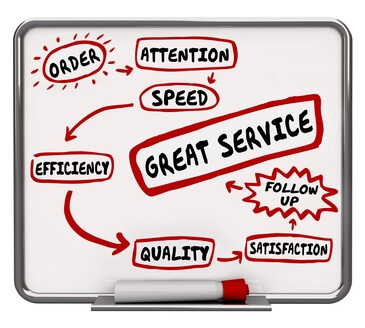
A customer journey map is best suited when you’re focused on a specific path – such as the buying journey for one specific type of target consumer for one specific product, service, or product/service line. An experience map, on the other hand, is the better choice if you’re aware that customers aren’t having the best experience they could be, but you’re not sure where the problem lies. Heart of the Customer offers two useful examples that can aid in understanding the ideal use cases for each of these customer strategy planning tools:
- A customer journey map was selected as the best tool for helping a hospital understand its radiology experience, from scheduling to receiving advanced imaging. In this case, a customer journey map was able to offer valuable insights to the organization about the specific touchpoints at which customers were becoming frustrated – and where the organization could focus its efforts to create a better patient experience and generate loyalty. While a journey map was the best tool for this specific purpose, it offered no value to the hospital’s departments outside of radiology.
- A customer experience map was used for a non-profit organization experiencing member disengagement at some point throughout their multi-year experience, but the organization was unsure where the disengagement was occurring or what events and interactions were catalyzing the shift. In this case, an experience map provided actionable results, revealing key insights that informed changes to the overall member experience, to restructuring its membership approach, and onward. After implementing changes on this level, the organization is able to then hone in on specific member (customer) journeys to improve individual experiences.
It’s easy to see how the two can be confused, but the best way to think about a customer experience map is that it’s a more all-encompassing visualization of the big picture, while journey maps are more focused, mapping the interactions a specific buyer persona has from first interaction to post-sale loyalty, or, in the most undesirable scenarios, customer attrition.
Customer Experience Maps: Addressing the Omni-Channel Experience
One key difference between experience maps and journey maps is that a customer experience maps the omni-channel experience. A customer journey map is more linear, mapping the specific touchpoints at which a consumer interacts with a brand on the path to purchase. Customer experience maps acknowledge the multitude of channels that customers interact with a brand throughout the buying journey in a more cohesive and comprehensive way. Here’s an example of a customer experience map from Adaptive Path:

Image via Adaptive Path
This is particularly important, as it’s increasingly common for consumers to navigate across channels to make buying decisions and purchases. In response, brands must embrace omni-channel marketing – adopting a holistic view with the customer at the center, based on the understanding that today’s consumers are navigating between a variety of touchpoints to make purchases. Even multi-channel marketing falls short by treating individual marketing channels as stand-alone entities with their own strategies, which often results in a disjointed and distinctly different experience from channel to channel. The goal, and a goal that can be achieved with customer experience mapping, is to foster a consistent, positive experience across every channel and at every possible touchpoint throughout the buyer’s journey.
Of course, one target consumer’s journey may be significantly distinct from another’s. That’s why customer journey mapping remains a valuable tool but should be undertaken as a follow-up to customer experience mapping when your organization is armed with the insights necessary for a more laser-focused effort.
Goals of Customer Experience Mapping
It’s always a good idea to start by identifying the business problem you hope to solve. If you’re just beginning to implement a customer experience program – or are about to revamp your existing program – customer experience mapping is an essential first step in the process.
The goal of customer experience mapping is to understand every conceivable way that a prospect or customer could potentially interact with your brand. That means a multitude of channels, through a variety of mediums, and with various goals of their own.
- Is a prospect trying to learn more about your niche before they even decide they need to make a purchase?
- Is a prospect comparing your products and services against your competitors’ offerings before making a buying decision?
- Or is an existing customer reaching out to various customer support channels for help solving problems they’re experiencing with your products or services?
Each of these interactions is distinctly unique (and they’re certainly not the only types of interactions a consumer might have with a brand), and even more so when you compare the same type of interaction across different channels and with prospects or customers fitting different buyer profiles.
Other goals of customer experience mapping include:
- Informing initiatives designed to increase customer satisfaction
- Identifying opportunities to foster brand loyalty
- Pinpointing touchpoints and experiences in-context that contribute to customer attrition
- Uncovering opportunities to improve customer retention
- Understanding where the user or customer experience is already well-supported
- Identifying opportunities for innovation (creating a competitive advantage)
The experience mapping process can reveal insights such as whether consumers have greater brand loyalty when they take one specific path to purchase (e.g., researching on social media, interacting with sales representatives, and eventually making a purchase via a website) compared to another, or if consumers who interact with your brand at a specific touchpoint post-purchase are more likely to churn.
Ultimately, mapping the customer experience can help you gain a deeper understanding of your customers, how they interact with your brand, and implement targeted initiatives that improve retention, enhance loyalty, and increase profits. By visualizing the entire customer experience, you create a useful dashboard and a valuable tool that can easily illustrate current challenges, opportunities, and even shortcomings to key stakeholders. For example, being able to demonstrate how a lack of engagement with existing customers in the post-purchase process is causing customer attrition makes for a compelling argument in favor of investing in a tool that improves post-purchase customer service.
Customer Experience Map Prerequisites
So, what do you need to get started mapping the customer experience? You’ll need to spend some time gathering and aggregating feedback from your customers and your employees. Here’s a look at the major prerequisites for customer experience mapping. 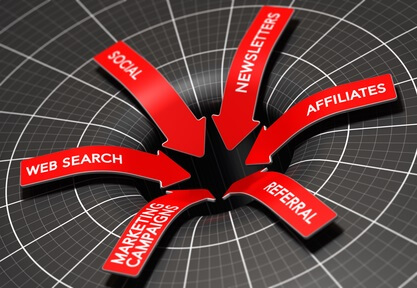
Take a complete inventory of all touchpoints. That includes your website, social media channels, traditional advertising (radio, print, TV), digital advertising (search advertising, social media advertising, etc.), telephone (sales reps, customer service reps, technical support reps), retail stores/physical locations, direct mail, and even invoices and receipts.
Map prospect or customer goals with touchpoints. In other words, what’s the purpose of the interaction? It can be helpful to identify the types of interactions prospects and customers may have with your brand, such as information gathering, customer support/problem solving, sales interactions, comparisons, and so forth.
Categorize touchpoints by phase. Consumers typically go through several phases throughout the buyer’s journey. Similar to the above point which addresses the purpose of the interaction, you may choose to identify the touchpoints that consumers through which consumers may interact with your business during each phase of the journey, from awareness, to consideration, to evaluation, to decision or purchase, and finally to the post-purchase experience.

Screenshot via Hubspot.com
Note that there are multiple models of the buying process, so you may include additional phases in your model based on the nature of your buyers’ journey and the typical phases that you consider part of the process when mapping content and other marketing, sales, and service initiatives. For instance, a circular model developed by David Court, Dave Elzinga, Susan Mulder, and Ole Jørgen Vetvik, described in an article published at McKinsey & Company, illustrates a circular buying process that incorporates four phases:
- Initial Consideration
- Active Evaluation
- Selection/Moment of Purchase
- Post-Purchase Experience
This model includes a trigger which activates the loyalty loop, as illustrated by the graphic below:
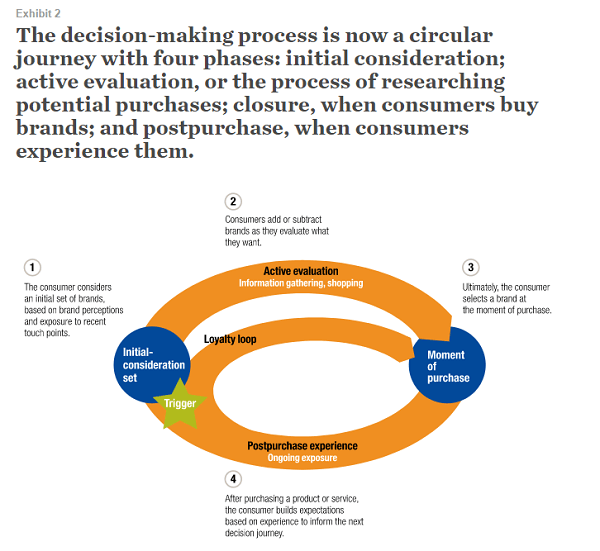
Screenshot via McKinsey.com
Identify the business reason for the existence of each touchpoint. What business purpose does each touchpoint serve? For instance, you may rely on social media as a marketing channel that supports the awareness-building stage, but also utilize channels such as Twitter and Facebook to support customer service initiatives in the post-purchase phase. A single channel can facilitate multiple touchpoints serving distinct purposes at various phases of the buying process.
Establish ownership of each touchpoint. Don’t make the mistake of attributing ownership by channel. It might be easy to give ownership of your social media channels to marketing, but doing so doesn’t acknowledge the use of those channels in the post-purchase phase for customer support – that’s why it’s crucial to establish ownership by touchpoint, identifying the department, team, or individual responsible for managing the experience at each and every touchpoint.
Mine your data. There are various methods for obtaining feedback from employees and customers and a wealth of data sources for additional data that can (and should) be considered in creating a customer experience map including:
- Surveys
- One-on-one interviews
- Logs and analytics from call centers
- Web analytics
- Buyer personas
- Blog comments
- Product and service reviews (Amazon, Yelp, etc.)
- Testimonials
- Social media (comments, reviews, etc.)
- Forums
- Customer support communications (email, chat, etc.)
No matter what research and data mining methods you utilize, you’ll want to gather enough insights to establish the purpose of every touchpoint from your customers’ perspective and quantify the effectiveness of every touchpoint – and supplement these insights with objective data whenever possible.
Determine the purpose of each touchpoint from the customer perspective. In the eyes of your prospects and customers, what impact does each touchpoint have? Does it strengthen your competitive advantage by informing consumers of the benefits of your products or services over those of your biggest competitors? Does it encourage cross-selling, up-selling, or repeat purchases? Or perhaps it enforces and strengthens customer loyalty. It’s not enough to understand your company’s “why” behind each touchpoint; it’s imperative that you also understand the “why” from your customers’ perspective.
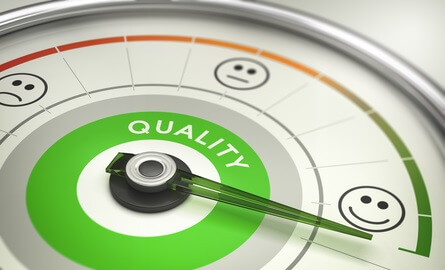
Quantify the effectiveness of each touchpoint. What do your customers expect from your company at each touchpoint, and are you meeting those expectations? Unmet needs can weaken the customer experience, so understanding precisely how your customers feel after every interaction is valuable insight that you don’t want to miss.
What’s more, you should be curious as to whether customer sentiment aligns with your goals at each touchpoint and in each context. If your goal is to make your customers feel a sense of urgency to make a buying decision, that they must invest immediately to solve their problem, for instance, and your research shows that they’re actually feeling rather laissez-faire, you’ve got some work to do.
To gather all of this data effectively, you should enlist representatives from every department – even those not directly interfacing with customers – to ensure that all perspectives are represented and every conceivable angle is addressed. After all, customer experience mapping is about a holistic view, and every department and every individual within your organization has an impact on the customer experience, no matter how direct or indirect.
Mapping the Experience
The information gathering and research phase is just the beginning of experience mapping process. The next phase is organizing and visualizing the insights you’ve gained during the research phase. This usually means translating raw data into informative, easily digestible, and actionable insights and presenting them in an aesthetically pleasing way.
UX Lady identifies three key considerations in this phase:
Layout. The two primary layouts used in customer experience mapping are timelines and wheels. A timeline can be laid out horizontally or vertically, with touchpoints positioned at appropriate points. The wheel layout is more feasible for mapping experiences that tend to cycle repeatedly, or those in which interaction phases are more relevant.
If you opt for the timeline layout, you have yet another consideration to weigh before beginning to physically map your data. Lenati points out that there are four ways to view your customer experience over time, from a macro to micro level:
- Customer Lifespan: Focuses on the customer’s lifespan, identifying phases throughout a customer’s life when they would be likely to have a need for a brand’s products or services. This consumer-focused view is typically measured in decades.
- Customer Brand Lifecycle: Similar to the Customer Lifespan but with a greater emphasis on the relationship between the consumer and the brand, the Customer Brand Lifecycle view limits the focus to customer acquisition, engagement, and loyalty. Therefore, this view covers a shorter time period. This view is often useful for sales funnel visualizations or engagement ladders. This is typically measured in years.
- Customer Journey: This view shows “a contained series of brand interactions and customer experiences.” Examples include a patient visiting a hospital for a specific procedure or a traveler’s experience with an airline or cruise line for a single trip; as it’s limited to a stand-alone event or experience, the time span is usually limited to hours or days.
- Customer Moment: This view has a laser focus on a single interaction between a consumer and a brand, such as the checkout experience on an e-commerce website or a customer service interaction to process a return at a retail store. Thus, it’s typically measured in minutes – sometimes seconds.
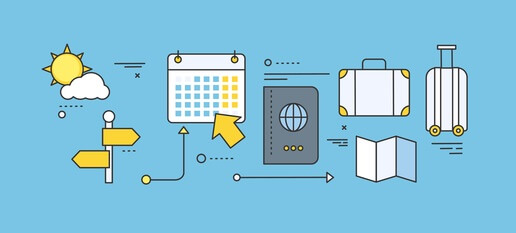
Content and Elements. There are a variety of content elements that may appear on a customer experience map, and there’s no single set of must-have elements that applies across the board to every organization. Content and other elements may include:
- User needs or experience triggers (the “problem” your customers are trying to solve)
- Indicators of a customer’s mental status at a given touchpoint in a certain context (such as their attitude, attention, mood, or motivation)
- The customer’s emotions, thoughts, or reactions
- Actions from the consumer’s or system’s perspective (or both)
- Touchpoints (including interaction points, pain points, or points of delight)
- Elements indicating a specific buyer persona or scenario
- Opportunities or service barriers (performance indicators)
Complexity. It’s not always necessary to include every element on an experience map. For instance, if your goal is to identify shortcomings in your system, you might choose to emphasize system action-related elements and customer reactions. Creating multiple experience maps using the same layout makes it possible to layer maps, reducing or increasing the complexity of information shown at a time.
As discussed earlier, the simplest experience maps – those that focus on a single user with a single goal who takes a single path in a single scenario (even when multiple variations are possible) – are more representative of the customer journey than the complete customer experience. Still, even customer experience maps can vary substantially in complexity depending on your goals and focus.
The more information-rich your experience map, the more complex the design will be by necessity. If you aim to integrate a variety of elements into your map, choose simplistic design elements (icons, arrows, etc.) that can illustrate the necessary data without adding unnecessary design complexity.
Niall O’Connor offers a comprehensive approach to customer experience mapping in this article at Medium, utilizing a sticky-note strategy that can be highly effective for early iterations, allowing you to move elements around as needed to accurately visualize every individual aspect of the customer experience. Others choose to use digital design tools to map out the experience, which still allows for multiple iterations and flexibility.
There’s no single approach or method that trumps all others across the board; your customer experience map is unique to your organization and should focus on meeting your specific goals rather than fitting neatly into a cookie-cutter template (although templates can certainly be helpful). As long as your experience map achieves what you’ve set out to accomplish and contains the characteristics of a successful map, you’ve done it right.
CX Mapping Tools and Templates
There are some dedicated CX mapping tools, but many marketers find a variety of different tools useful in the mapping process. For instance, you might use a combination of data mining and analysis tools and graphic design or planning software to gather your data and visualize your information.

Screenshot via Smaply
Here are a few tools dedicated to the cause of journey mapping and CX mapping:
- Smaply – Create professional buyer personas, journey maps, and even stakeholder maps in minutes with this web-based software tool.
- UXpressia – Another web-based tool, UXpressia makes it easy to create personas and customer journey maps.
- Experience Fellow – Dedicated to CX visualization, Experience Fellow facilitates gathering valuable customer and employee feedback as well as visualizing data.
- CFN Insight – A useful tool for delivering a best-in-class customer experience, CFN Insight acts as a CX workflow solution.
- Canvanizer – You can map all sorts of things with Canvanizer, including the customer experience.
- MindMeister – Mind mapping tools like MindMeister are among the most useful and flexible CX mapping tools. Check out this tutorial on Medium for a how-to on creating a CX map template in MindMeister.
This, of course, is by no means a comprehensive list, but gives you a bit of insight into the types of tools available to streamline the mapping process. As CX mapping gains prominence, there’s a good chance you’ll see similar tools emerging to meet the need.
There are also many templates you can use, build on, and customize to meet your needs. While you shouldn’t try to force your data into an existing template, working with a template can be a good starting point if you’ve never mapped the customer experience before – and in some cases, it’s entirely possible that you’ll find a template that suits your needs perfectly. That said, most of the readily available templates focus on the customer journey rather than CX, but they can still be helpful tools for getting started:
- Design Thinkers Academy – While this is a customer journey mapping template, it contains many useful fields that can be used for mapping the experience, as well.
- Content Marketing Institute – Again, this is a customer journey map template, but customer journeys are part of the experience, so these types of templates can be useful for getting started with CX mapping as well.
- Tobi Johnson’s Customer Journey Worksheet – Use this template to start gathering key data that can inform your CX map.
- XPlaner’s Culture Map – Gain insights into your company’s culture with this worksheet.
- Empathy Map Template – This is a helpful tool for gathering customer insight.
- CX Partners – CX Partners offers several templates, tools, and worksheets you can use to facilitate the information-gathering and mapping process.
What Makes a Good Customer Experience Map?
So, what characteristics should a successful map have, anyway? When you develop a customer experience map that considers all of the above elements and variables, is well thought-out, backed by data, and visually represented in a meaningful but simplistic manner, the odds are good that your initiative is successful. However, there are a few important questions to ask yourself before finalizing your project to determine its potential value across your organization:
- Does it stand on its own? A good customer experience map should be easily distributed across an organization, to various departments and stakeholders, and be relatively easy to understand without much explanation – ideally, no additional explanation should be necessary.
- Does it incite action? While it may be a great feeling to complete such a tremendous undertaking (mapping the customer experience is no joke!), it’s not an end in itself, but a catalyst to further action that furthers company goals.
- Is it customer-focused? A good customer experience map places the customer at the center of the experience and focuses on the needs, behaviors, and outcomes from the customer’s perspective.
- Does it identify strengths and weaknesses? If you’ve mapped the experience sufficiently, current shortcomings and opportunities should be clear.
- Does it eliminate silos? The customer experience doesn’t exist in a silo, but too many organizations treat it as such. That’s why experience mapping is such a valuable tool for creating a more consistent brand experience across the organization. Your map should eliminate silos, taking into account every possible interaction with your brand from start to finish.
Remember, there’s no single right way to map the CX. Your map doesn’t have to (and shouldn’t) look like another brand’s. Focus on meeting your organization’s goals and passing the litmus test, and you’ll have a successful outcome.
Additional Resources and Tutorials
Visit the following resources and tutorials for more information on specific aspects of customer experience mapping, graphic design tips, understanding CX, journey mapping, and more:
- How to Create a Customer Journey Map
- The Truth About Customer Experience
- 10 most interesting examples of Customer Journey Maps
- Experience mapping tools
- The Customer Experience Journey Mapping Toolkit
- Customer Experience Mapping: What Is It and How to Do It?
- The 50 Best Customer Journey Mapping Tools
- How to Run an Empathy & User Journey Mapping Workshop
- How to Build a Customer Journey Map that Works
- CX Tool Kit: Defining Your Customer Experience
- The difference between a journey map and a service blueprint






